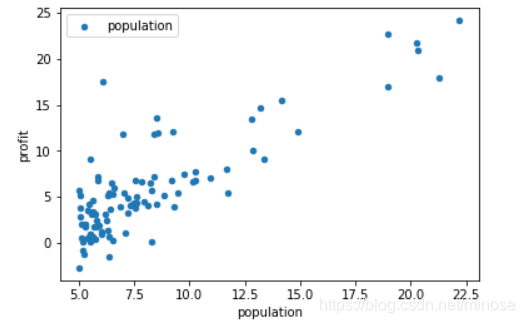1-单变量线性回归
案例:假设你是一家餐厅的CEO,正在考虑开一家分店,根据该城市的人口数据预测其利润。
我们拥有不同城市对应的人口数据以及利润: ex1data1.txt
- 先引入库
import numpy as np
import pandas as pd
import matplotlib.pyplot as plt
- 读取数据
data = pd.read_csv('ex1data1.txt',names=['population','profit'])
data.head() #打印前5行看看
---------------------------------------
population profit
0 6.1101 17.5920
1 5.5277 9.1302
2 8.5186 13.6620
3 7.0032 11.8540
4 5.8598 6.8233
--------------------------------------
data.plot.scatter('population','profit',label='population') #绘制散点图
plt.show()

- 处理数据
data.insert(0,"ones",1) #为了方便矩阵化运算,先插入一行全为1的值
data.head()
插入完后data长这样

X = data.iloc[:,0:-1] #获取前三列 iloc[行,列],并且 : 的区间范围左开右闭,比如说这里是[0,-1)
y = data.iloc[:,-1] # 获取最后一列
X = X.values # 将dataframe类型转为数组类型
y = y.values
X.shape #看一下维度
(97, 2)
y.reshape(len(y),1)
y.shape
(97,1)
- 代价函数

根据公式定义一个代价函数~
def costFunc(X,y,theta):
inner = np.power((X @ theta)-y,2)
return np.sum(inner) / (2*len(X))
现在还需要定义下theta
theta = np.zeros((2,1)) #初始化数据为0,
theta.shape
(2,1)
firstCost = costFunc(X,y,theta)
print(firstCost)
32.072733877455676
- 梯度下降
为了求得代价函数的最小值,采用梯度下降的方法~
先定义下梯度下降函数

def gradDesc(X,y,theta,alpha,iters): #alpha 学习速率,iters迭代次数
costs = [] # 记录每次的cost
for i in range(iters):
theta = theta - (alpha/len(X) * X.T @ (X@theta -y) )
cost = costFunc(X,y,theta)
costs.append(cost)
if(i % 100 == 0):
print(cost)
return theta,costs
alpha = 0.02
iters = 1000
theta , costs = gradDesc(X,y,theta,alpha,iters)
print(costs)
打印costs,看得出代价每次都在减小
16.769642371667462
5.170668092303259
4.813840215803055
4.640559602034057
4.556412109403549
4.5155489085988645
4.495705166048674
4.486068766778817
4.481389196347322
4.479116731414093
通过画图更直观的看一下
fig,ax = plt.subplots()
ax.plot(np.arange(iters),costs)
ax.set(xlabel='iters',
ylabel='cost',
title='cost vs iters')
plt.show()

最后,划出拟合的直线
x = np.linspace(y.min(),y.max(),100) #从最小值到最大值的100个均匀的点
y_ = theta[0,0] + x #拟合的直线
fig,ax = plt.subplots()
ax.scatter(X[:,1],y,label='training data')
ax.plot(x,y_,'r',label = 'predict')
ax.legend()
ax.set(xlabel='populaiton',
ylabel='profit',)
plt.show()























 948
948











 被折叠的 条评论
为什么被折叠?
被折叠的 条评论
为什么被折叠?








